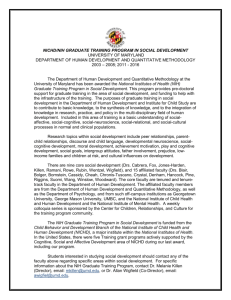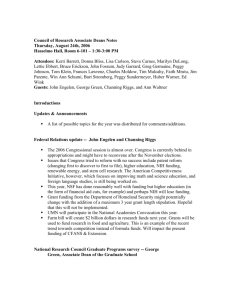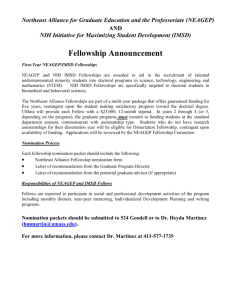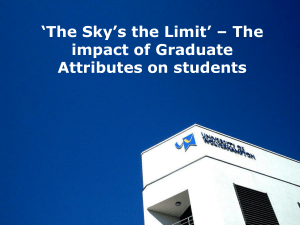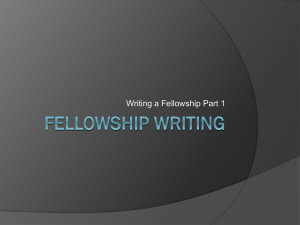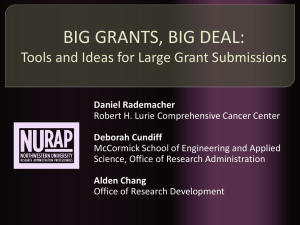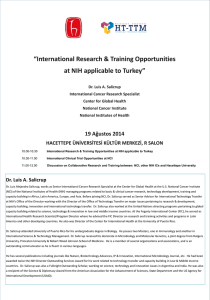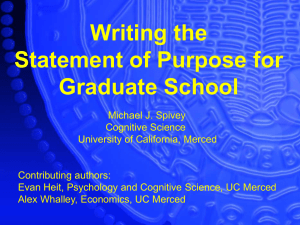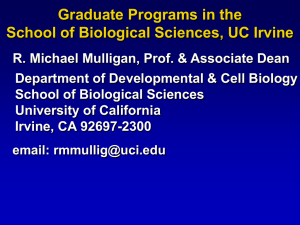Are you ready? - Case Western Reserve University School of Medicine
advertisement
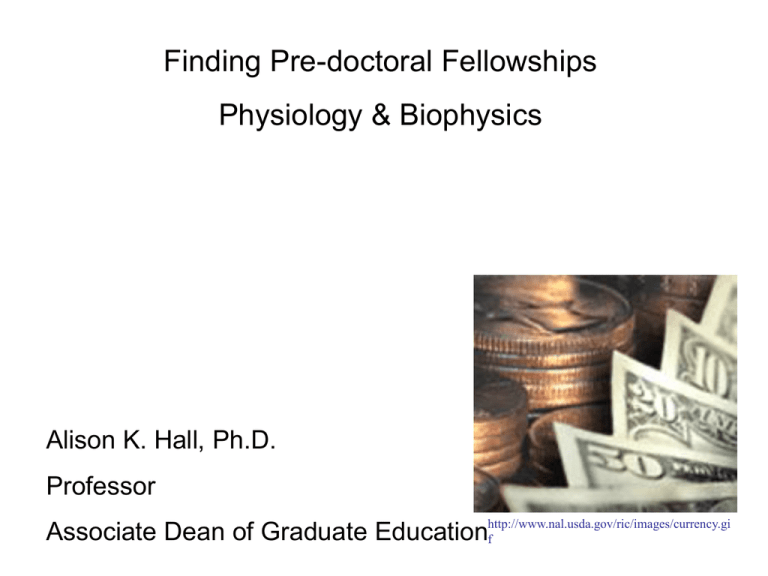
Finding Pre-doctoral Fellowships Physiology & Biophysics Alison K. Hall, Ph.D. Professor Associate Dean of Graduate Educationhttp://www.nal.usda.gov/ric/images/currency.gi f So, you’re thinking of a Graduate Fellowship Proposal why write one? where does this fit in my career? when do I write this? what is in a fellowship proposal anyway? what makes a strong proposal? why write one? 1. Develop your own ideas 2. Benefits associated with grant 3. Looks good on your resume 4. Great learning experience 5. Can engage active PI mentorship Where does this fit in my career? Communicate your PI, potential mentors/committee Graduate Education examples Grants and Contracts (era username) Are you ready? pilot data time to focus appointment status deadlines Do you qualify? fellowships in topic areas citizenship Is there money? How will I find it? 1.NIH, NSF, DoD; The Feds “National goals” US citizens and permanent residents diversity Multiple deadlines each year Almost formulaic 2.Foundations and Agencies Non-citizens usually okay One deadline a year Can be quirky mission Prepare the Application: read the instructions!! start early, seek internal reviewers The NIH F30/31 Individual Ruth L. Kirschstein National Research Service Award F Kiosk http://grants1.nih.gov/training/F_files_nrsa.htm electronic submission through Grants.gov to eRA Commons F30 Predoctoral MD/PhD Fellows F31 to Promote Diversity in Health-Related Research F31 Individual Predoctoral Fellows Not all Institutes participate in this mechanism set stipend scale, supplement from PI, program Predoc Postdoc yr 0 Training Related Expenses 21,600 38,496 what is in a fellowship proposal anyway? Form pages including UG, grad grades, GRE, MCAT, USMLE Biosketches Research Training Plan 6 pages specific aims--3, 3 years background, preliminary studies research design and methods two new techniques, collaborators human subjects, vertebrate animals literature cited Your career and training goals publications, meetings, didactics Mentor’s career development plan for you* 3 sealed letters of reference Deadlines usu Feb8, June8, Oct 8 http://grants.nih.gov/training/nrsa.htm Case has few NIH F awards NIH Reporter http://projectreporter.nih.gov/reporter.cfm NIH Spending Categorization Project Title Project Number Aging;Alzheimer's Disease;Brain Disorders;Neurodegenerative;Neurosciences TOLL-LIKE RECEPTORS AND INNATE IMMUNE ACTIVATION IN ALZHEIMER'S DISEASE 1F30AG03811 CAMERON, BRENT DAVID 1-01A1 Bioengineering;Cardiovascular;Clinical Research;Diagnostic Radiology;Heart Disease INNOVATIONS INVOLVING BALANCED STEADY STATE FREE PRECESSION MRI 5F30HL09400 DERAKHSHAN, JAMAL JON 2-03 No NIH Category available. NON-REDUNDANT FUNCTIONS OF HU PROTEINS 5F31NS06472 HINMAN, MELISSA N AS NEURON-SPECIFIC SPLICING REGULATORS 4-02 No NIH Category available. THE WT1 INTERACTING PROTEIN: A CHOREOGRAPHER OF MORPHOLOGY AND TRANSCRIPTION 5F30DK08389 KIM, JANE 7-03 Eye Disease and Disorders of Vision;Infectious Diseases THE PATHOGENESIS OF ASPERGILLUS KERATITIS 5F31EY01984 LEAL, SIXTO MANUEL 1-02 Biotechnology;Depression;Mental Health;Neurosciences CONTROL OF SEROTONERGIC SIGNALING BY CHIMERIC LIGHT ACTIVATED RECEPTORS 5F30MH08437 OH, EUGENE 1-03 No NIH Category available. DETERMINING THE CELLULAR MECHANISMS OF 1F31DC01121 SCHMIDT, LOREN JANES GAMMA OSCILLATIONS IN THE OLFACTORY 3-01A1 BULB. No NIH Category available. CONTROL OF CELL GROWTH BY MTOR AND BMP 5F31CA14231 WAHDANALASWAD, IN PROSTATE CANCER 1-02 REEMA SAID Alcoholism;Chronic Liver Disease and Cirrhosis;Clinical Research;Digestive EFFECT OF ALCOHOL AND OPIOIDS ON DC Diseases;Emerging Infectious Diseases;HIV/AIDS;Hepatitis;Hepatitis - C;Infectious FUNCTION IN HCV AND HIV INFECTION Diseases;Liver Disease;Substance Abuse Contact Principal Investigator 5F31AA01785 YONKERS, NICOLE L 3-03 National Defense Science & Engineering Graduate Fellowship (DoD) http://ndseg.asee.org/ Aeronautical and Astronautical Engineering Biosciences Chemical Engineering Chemistry Civil Engineering Cognitive, Neural, and Behavioral Sciences Computer and Computational Sciences Electrical Engineering Geosciences Materials Science and Engineering Mathematics Mechanical Engineering Naval Architecture and Ocean Engineering Oceanography Physics American Heart Association http://www.americanheart.org/presenter.jhtml?identifier= 9713 Ohio is in Great Rivers Affiliate Helps students initiate careers in cardiovascular or stroke research by providing research assistance and training. NSF Graduate Fellowships http://www.nsf.gov/funding/pgm_summ.jsp?pims_id=62 01&org=NSF American Heart Association-Ohio Barron, Victoria A American Heart AssociationOhio Human Genetics Lee, Elaine American Heart AssociationOhio Biomedical Engineering Engineering Graduate Student Muralidharan American Heart Association, Abirami Ohio Biomedical Engineering Engineering Graduate Student Beamish, Jeffrey American Heart AssociationOhio Biomedical Engineering Engineering Graduate Student Hong, Shiyuan American Heart AssociationOhio Physiology & Biophysics School of Medicine Graduate Student American Heart AssociationHu, Wenqian Ohio RNA Center School of Medicine Graduate Student Kapadia, Fehmida Cardiology Medicine UH School of Medicine Graduate Student Pediatrics UH School of Medicine Graduate Student American Heart AssociationOhio Karunamuni, American Heart AssociationGanga Ohio School of Medicine Graduate Student How will I find money? http://sciencecareers.sciencemag.org/funding Info on science careers, etc Grants net http://grantsnet.org/search/srch_specify.cfm Go to “advanced search” in blue tab Tabs: research funding/ student support Research / teaching, policy etc Experience level: PhD dissertation student Type of Application: Individual CWRU Graduate Education website http://casemed.case.edu/gradprog/grantsources.html What makes a strong proposal: easy to review! Proposal is read by smart non-experts and summarized quickly Phyllis McBride, Ph.D. p-mcbride@tamu.edu what makes a strong proposal? A good idea A strong research idea should pass the “so what” test. What is the benefit of answering your question? Who will it help and how? If you cannot make a definitive statement about the purpose of your research, it is unlikely to be funded. What makes a strong proposal: Novel hypothesis • Provide a rationale—where did hypotheses they come from, and why are they strong? • Have ideas logically related to you and the lab • Propose testable and measurable studies • Provide alternative possibilities that could be tested why did you choose the ones you did over others • Clear training potential What makes a strong proposal: 3 Specific aims steps you are going to take to test your hypotheses what you want to accomplish in the course of the grant period Make sure: Your objectives are measurable and highly focused Each hypothesis is matched with a specific aim The aims are feasible in technique, time and money http://www.theresearchassistant.com/tutorial/2-1.asp What makes a strong proposal: some Pilot data For F30, perhaps a year of work? The goal of this section is to demonstrate experience and competence to perform the proposed project Often, the feasibility of your proposed study is demonstrated through the report of pilot data Can include work of others in lab if cited Try your hardest to collect pilot data, even if your N is small. What makes a strong proposal: Career Development Research is NOT the only thing! You articulate how this research training plan increases Likelihood for career success Your PI must articulate a training plan for you Not just research 24/7 Seminars, courses Cold Spring Harbor, collaborations Thesis committee Publication and presentation goals New techniques Presentation skills Resources at University for career development Do not give up!! You want to earn support Your mentor wants you to earn support Your study section wants to support you Pay attention to the summary statement Resubmit Expect to work at funding, and Enjoy the outcomes What happens to your application after it is submitted? Scientific Review Group in Center for Scientific Review Study section review// supplements Scores and percentiles Summary sheet Phyllis McBride, Ph.D. p-mcbride@tamu.edu
